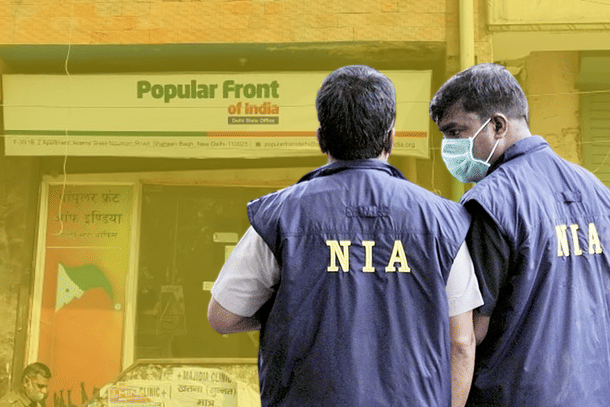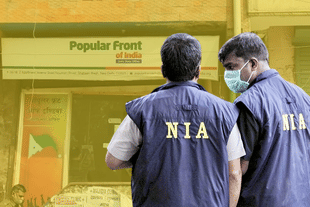Politics
Explained: The Politics Of PFI And Violence In Kerala After NIA Raids
Venu Gopal Narayanan
Sep 24, 2022, 03:04 PM | Updated 03:04 PM IST
Save & read from anywhere!
Bookmark stories for easy access on any device or the Swarajya app.


Early on 22 September, the National Investigation Agency (NIA) and the Enforcement Directorate (ED) conducted a coordinated blitzkrieg crackdown in fifteen states, on the Popular Front of India (PFI) – a radical Islamist outfit.
Over a hundred PFI members were arrested across the country in this sweep against both terrorism and the foreign funding of terrorist activities.
These raids were inevitable since the PFI had for long been accused of planning and instigating communal riots, and of executing hundreds of terrorist attacks across India in the past three decades through a phalanx of avatars.
It has hoary roots and has been linked by everyone with everything, from the narco-jihad mafia and the love-jihad mafia, the anti-CAA protests, the Easter bombings in Colombo, Sri Lanka, and to odious, banned jihadi outfits like the Lashkar-e-Taiba, Students Islamic Movement of India (SIMI), Indian Mujaheddin, the Bhatkal brothers, Al Qaeda, and even the Islamic State.
Today, the PFI is the most potent force actively involved in the radicalisation of Muslim youngsters in India, and is at the forefront of a vitiating cultural separatism sweeping the land anew.
Compared to it, Asaduddin Owaisi, Badruddin Ajmal, and the Indian Union Muslim League (IUML) would seem like cuddly teddy bears. And, an ED angle to the raids, points to a strong extraneous influence, bolstered by copious funding from abroad.
The biggest jolt to the PFI was in its epicentre, Kerala, where its National Chairman, OMA Salam, national secretary, state president, and national council member were all arrested from the Moplah-dominated district of Malappuram, in south Malabar.
On cue, small groups of PFI members gathered on the streets of our major cities to protest against the crackdown, while the secular marches of social media rushed to self-flagellate themselves in a guilt-tripping frenzy of anti-fascist fury and empathetic Muslim victimhood.
But the real reaction came the next day, 23 September, when the PFI declared a dawn-to-dusk hartal in Kerala. They went on a furious rampage across the state to impose their fiat. And what a rampage it was!
In a fit of Islamist fury which Kerala hasn’t witnessed in ages, PFI protestors stoned state transport corporation buses across the length of this long state.
Hundreds were arrested, and hundreds more detained, but only after the damage was done, and the bloodlust of the PFI had been sated following unprecedented vandalism.
That begs a few questions.
How does a fringe outfit muster the clout to impose a hartal across a state, and wreck so much havoc with such impunity?
Why is the Communist government tiptoeing around the violence, just as it did with the Catholic priests protesting at Vizhinjam port?
How come there was violence only in Kerala, even though the NIA and ED conducted raids and made arrests in over a dozen states of the union?
To answer the question of clout first, the PFI represents a transition beyond the cosy link enjoyed by the Congress with the IUML for decades (and the Communists before that, lest we forget).
For over half a century, the secular parties turned a blind eye as Malabar was transformed into an IUML preserve, and the League returned the favour by opening up vistas to the riches of the Middle East.
The PFI’s success, though, has a distinctly different theological basis: to prevent Indian Muslims from entering the cosmopolitan mainstream by harping on, and clerically reinforcing, the message of individual piety, and the importance of collective purity, while simultaneously rejecting the old hold of the traditional Muslim elite (the IUML in the south, and the Ashrafi aristocracy in the north).
The propagation of this message, and the galvanisation of youngsters into their ranks, is conducted with admirable, tech-savvy efficiency through the digital domain.
Consequently, unquestioning obedience and rapid mobilisation are both possible as soon as a threat to the organisation is perceived. That is how groups managed to gather so quickly in the streets even as the raids were in progress, and why much of the serious vandalism in Kerala took place before mid-morning of the hartal day.
Note also, that the PFI steers clear of stereotypical Wahhabi imagery. No moustache-less beards, headgear, or flowing robes for them. Instead, its leaders, like OMA Salam, usually appear in public dressed neatly in pants and plain shirts.
Confrontation is more important to them than costume, in their quest for pan-Indian Muslim unity. That is why the majority of PFI members who gathered publicly across India to protest the raids, were dressed ‘normally’, and pertinently, without the Taqiyah, or Muslim skullcap.
For the same reasons, there is no love lost between the IUML and the PFI. The IUML has long tried to spread its wings beyond Kerala. A little-known fact is that members of the IUML were involved in the anti-CAA riots of December 2019 in Sambhal, Uttar Pradesh.
Yet, while it has tasted some sporadic success in Tamil Nadu, it remains a Malayalee entity for all practical purposes. The PFI’s expansion at the national level, on the other hand, has been staggering.
The League’s schadenfreude at the PFI raids, therefore, was visibly apparent, when its PK Firoz (himself accused of misappropriating party funds!) publicly accused the PFI of spreading disharmony.
Regarding the Communists’ gingerly response to the PFI’s orchestrated mayhem, the answer is as political as it is subjective. One conspiratorial hypothesis is that the PFI is a put-up job by the Communists, to counter the IUML.
Another, equally convoluted, theory says that the PFI is the by-product of efforts by a section of the Communists to woo the IUML away from the Congress.
Now, it is true that there have been periodic efforts by the Left to ally with the IUML; and, that such episodes have invariably been followed by intense churning both within the Left, and the Moplah community.
Either a faction of the Left is excised, or a new set of non-IUML, Left-backed, Muslim entities appear in the electoral space.
In 1985, the ‘Badal-rekha’ incident led to the rise of a new Communist leader named Pinarayi Vijayan. In the 2006 Kerala assembly elections, the IUML was reduced to an historic low of just seven seats, and suffered the ignominy of losing key seats in ‘their’ Malappuram to the Communists.
In April 2022, Swarajya reported on the latest aborted attempt at a tie-up, and the hilarious manner in which both sides fell over each other trying to deny that talks were on. This level of detail may be tedious to the average reader, but it is, in fact, the only way to understand the intricate communal-secular dynamics at play.
Nonetheless, and speculative theorising aside, the actual reason why the Left tiptoed around the PFI’s rampages lies in the answer to our third question – why did violence happen only in Kerala?
It has two parts. At the political level, a kid gloves handling of the Indian Union Muslim League (IUML) by the secular parties, during the League’s quest for a Sultanate of Eranad in everything but name, is what created an enabling environment for the PFI.
Dinesh Gundu Rao of the Congress offered confirmation of this thesis; he told the press that the PFI and the RSS were up to the same thing (whatever that is). It is the creation of such false equivalences which allowed the PFI to grow to the extent that it became a major national security threat.
At the electoral level in some southern states, particularly in Kerala, the PFI’s political wing, the SDPI (Social Democratic Party of India), has been tacitly deployed to upset the Congress and its allies at places.
It is also present in the north, in strength, but this is not immediately apparent since it has been formally and organically subsumed, for the time being, by the non-Congress secular parties there.
Note how Samajwadi Party MP for Sambhal constituency in Uttar Pradesh, Shafiqur Rahman Barq, was quick to denounce the NIA-ED raids, and defend the PFI. This is a cruel joke, since the SDPI is patently un-social, un-democratic, and un-Indian.
In the past two Karnataka assembly elections, the PFI’s SDPI has consistently turned two seats in old Mysore state into a lottery (169-Chickpet and 218-Narasimharaja).
In Tamil Nadu too, they are firmly on the fringe, but in 2016 and 2021, SDPI candidates did poll nearly as much as the victory margin in a few seats.
Naturally, the scale of the PFI’s electoral participation is much more in Kerala, since it is their mainstay – politically, intellectually, financially, and organisationally. In 2021, they contested 40 assembly seats. They won nothing and got less than one per cent of the vote.

But, in a state like Kerala, where victory margins are traditionally quite narrow, the data shows that the PFI-SDPI helped the Left-coalition win in at least four seats by cutting the Congress-led coalition’s votes.
Thus, in conclusion, we see that the PFI has metastasized so much that it is not just one of the most serious security threats in the country today but has also garnered enough influence in the socio-political domain to influence electoral outcomes, trigger violence on demand, and make secular administrations like the Left think twice before clamping down on their vandalism. That is the power of the identity vote.
Obviously, then, the NIA-ED raids came not a moment too soon. Sadly, though, while the PFI’s back may be broken by the investigative agencies, and the threat it posed finally nipped, its core objective will continue to fester – to prevent Indian Muslims from joining the mainstream.
This is the price we pay for having been led by secularism for so long.
(All electoral data from Election Commission of India website.)
Also Read: After PFI Crackdown, Thinking Muslims Must Ask Themselves 10 Questions
Venu Gopal Narayanan is an independent upstream petroleum consultant who focuses on energy, geopolitics, current affairs and electoral arithmetic. He tweets at @ideorogue.





